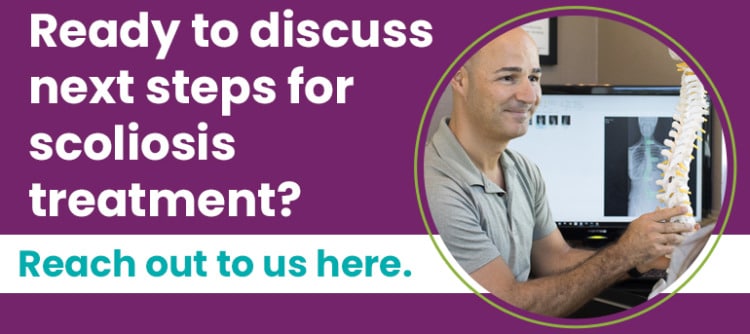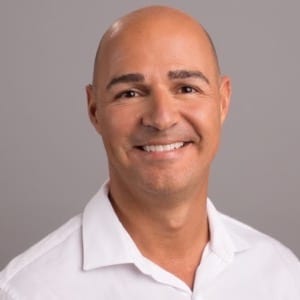Scoliosis History: Evolution of Diagnosis and Treatment
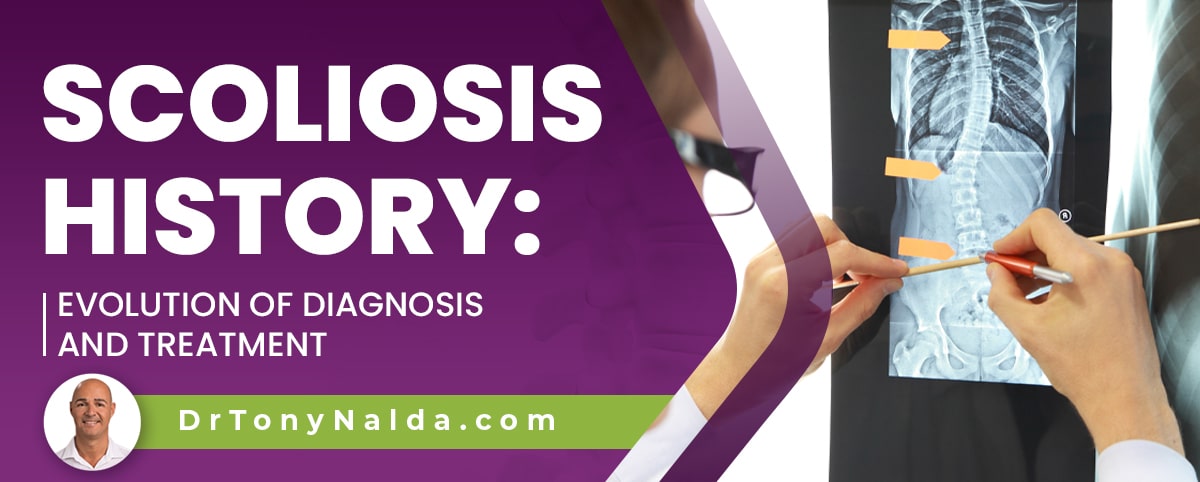
Scoliosis history extends back to ancient times when the condition was first observed and documented by a Greek physician named Hippocrates, who lived around 400 B.C. Approximately five centuries later, Greek physician, Galen, coined the name scoliosis from the Greek word for crooked or bent: skolios.
Scoliosis is a highly-prevalent spinal condition that has been around since ancient times. Ancient Greeks considered scoliosis to be a deformity that required correction through a variety of means: being tied to sticks, pulled, and stretched; we have since learned how to treat it effectively.
Although we don't fully understand scoliosis causation, our understanding of treatment efficacy has evolved over the years to include both surgical and non surgical treatment options.
Table of Contents
Early Scoliosis Treatments
Scoliosis causes the spine to bend and twist unnaturally, and as a progressive condition, the nature of scoliosis is to get worse over time.
Viewed as a deformity, the goal of ancient treatment was deformity correction, and this could involve a number of extreme approaches, including tying patients to sticks in an attempt to hold the spine straight, and pulling and stretching patients with the goal of spinal extension capable of straightening the spine.
While tying patients to sticks sounds extreme, this is actually the germ of the idea behind the evolution of spinal fusion surgery as a treatment option.
Less-invasive early treatment options included hydrotherapy; ancient Greek and Roman baths were a part of culture and treatment for a variety of ailments.
Diet and exercise were additional early treatments.
So before getting to the specifics of what we've learned about scoliosis treatment over the years, let's touch on what we still don't know about the condition.
What Causes Scoliosis?
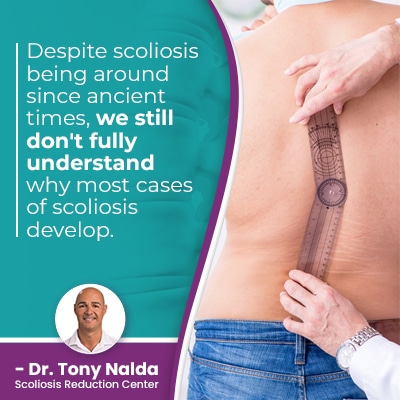 Despite scoliosis being around since ancient times, we still don't fully understand why most cases of scoliosis develop.
Despite scoliosis being around since ancient times, we still don't fully understand why most cases of scoliosis develop.
Scoliosis is often deemed a complex condition to treat, and this is because no two cases are the same.
Scoliosis ranges widely in severity from mild scoliosis to moderate, severe, and very severe scoliosis, and there are multiple condition types; in the most common type, idiopathic scoliosis, we don't know what triggers its initial development, but we do know it's growth that makes it progress.
As idiopathic scoliosis accounts for approximately 80 percent of known cases, we don't understand why most cases develop, but we do know it's growth that triggers progression; the remaining 20 percent have known causes and include neuromuscular scoliosis, degenerative scoliosis, and congenital scoliosis.
Part of diagnosing scoliosis involves comprehensive assessment including condition type, severity, and curvature location; scoliosis can affect any of the spine's main sections (cervical spine, thoracic spine, and the lumbar spine).
The diagnostic parameters for scoliosis have also changed over the years.
Diagnosing Scoliosis History
There are a number of spinal conditions capable of causing the development of an unhealthy spinal curve, and prior to the advent of X-ray imaging, a diagnosis of scoliosis was based on physical changes and observation.
What we now know is that scoliosis doesn't just cause the spine to bend unnaturally to the side, but also twist, and in order to confirm preexistent vertebral rotation, the spine needs to be X-rayed, and in addition, a minimum Cobb angle measurement of 10 degrees is necessary to be diagnosed as scoliosis; this measurement can also only be determined during X-ray.
So while it can be possible, and was in the past, to see a person has an unnaturally curved spine with the naked eye, to treat it effectively, specific details and measurements need to be determined so treatment plans can be fully customized.
The X-ray was invented in 1895, and shortly thereafter was applied to the diagnosis and treatment of scoliosis.
Cobb Angle Measurement
A patient's Cobb angle is a key piece of information treatment plans are shaped around, and condition severity is based on.
The higher a patient's Cobb angle, the further out of alignment the spine is, and the more severe the scoliosis is.
The more severe scoliosis is, the larger the unnatural spinal curve is, the more rotation there is, and the more complex it will be to treat.
The advent of the X-ray and the Cobb angle measurement is still the gold standard when it comes to diagnosing, assessing, and treating scoliosis.
It was in the 1970s that a Dr. William Kane called for a diagnostic cutting-off point for scoliosis, along with the standardization of treatment across different treatment providers and Care centres.
Thanks to the advent of the X-ray and the Cobb angle measurement, we can really see what's happening in and around the spine, and this is by far the most significant advancement when it comes to scoliosis assessment and treatment.
As such a highly-variable condition that doesn't just range from mild to very severe, but also has different condition and curvature types, the information provided by X-ray imaging is needed to customize treatment plans and address the condition's complexities.
Traditional Surgical Treatment
When discussing early scoliosis treatment methods among ancient cultures, tying patients to sticks was mentioned; while this can seem barbaric to us now, this was the germ of the idea behind modern spinal fusion surgery.
While the materials have evolved from using sticks applied to the outside of a patient's body to metal rods attached to the spine itself with internal fixation, the concept is unchanged, involving applying some type of hardware to keep the spine in a straight and aligned position.
The first spinal fusion surgeries were performed in the early 20th century and commonly involved fusing the curve's most-tilted vertebrae into one solid bone, removing intervertebral discs that sit between adjacent vertebrae to be fused, and attaching metal rods with pedicle screw instrumentation to hold the spine in position.
Traditional scoliosis treatment funnels patients towards spinal fusion surgery by not applying treatment while mild, commonly recommending watching and waiting, and responding with a surgical recommendation when/if conditions progress and become severe.
While surgical treatment was the dominant choice for many years, that doesn't mean it was the best or only treatment option available, and over the years, we've learned that a number of non surgical treatment options can also be effective.
Modern Conservative Non Surgical Treatment
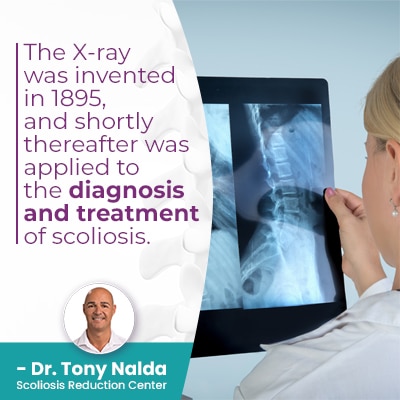 Modern conservative non surgical treatment has proven results that speak for themselves and prove that not all cases of scoliosis require spine surgeons to correct scoliosis.
Modern conservative non surgical treatment has proven results that speak for themselves and prove that not all cases of scoliosis require spine surgeons to correct scoliosis.
While we don't always know what causes idiopathic scoliosis to develop initially, we know it's growth that makes it progress, and adolescent idiopathic scoliosis is the most prevalent type overall.
Regardless of type or severity, all scoliosis patients can benefit from treatment; as a progressive condition, the nature of scoliosis is to get worse over time.
Curve progression can be prevented with early detection and intervention, but there are never treatment guarantees.
Conservative Treatment Modalities
Modern conservative treatment is innovative and integrative and combines the power of multiple treatment modalities such as chiropractic care, physical therapy, scoliosis specific exercises, corrective bracing, and rehabilitation.
Surgical treatment can be effective at straightening a bent spine, but the way it does so is contrary to the spine's natural movement-based design, and can disrupt the spine's overall health, strength, and function.
So while a lateral curvature of the spine can be addressed with spinal surgery, it is an invasive procedure, and modern conservative scoliosis treatment is proactive so is started immediately following a scoliosis diagnosis; the sooner treatment is started, the better.
The scoliotic spine only gets more rigid with progression, making it less responsive to treatment, so there are a number of benefits associated with a proactive treatment approach that works towards a curvature reduction on a structural level, along with improving the spine's surrounding muscle strength and balance.
Conclusion
Scoliosis history culminates in the success of modern scoliosis treatment that's non surgical because it means we have come to understand how scoliosis responds to different types of treatment.
While scoliosis history is far-reaching, we still don't fully understand the cause of idiopathic scoliosis, but we know what happens to untreated idiopathic scoliosis; it's likely to get worse over time and require scoliosis surgery in the future.
With the scoliosis research society putting current estimates at close to seven million people living with the condition in the United States alone, the condition is highly prevalent, and risk factors include gender, age, and a family history.
Scoliosis correction doesn't have to involve modern surgery, and while there are no treatment guarantees, a scoliosis deformity that's addressed early and effectively can be highly responsive and treatable.
While postural changes are the main effect in children (uneven shoulders, hips, and the development of a rib hump), spinal growth counteracts compression; scoliosis becomes a compressive condition once skeletal maturity has been reached, and this is why adult scoliosis is commonly painful.
Untreated scoliosis patients are at risk for mild and moderate scoliosis curves to become severe and very severe scoliosis, and adolescent patients are the most at risk for rapid progression due to the growth that takes place during puberty.
Patients of the Scoliosis Reduction Center® benefit from a modern proactive multifaceted approach to treating scoliosis without the risk of invasive surgery.
Dr. Tony Nalda
DOCTOR OF CHIROPRACTIC
After receiving an undergraduate degree in psychology and his Doctorate of Chiropractic from Life University, Dr. Nalda settled in Celebration, Florida and proceeded to build one of Central Florida’s most successful chiropractic clinics.
His experience with patients suffering from scoliosis, and the confusion and frustration they faced, led him to seek a specialty in scoliosis care. In 2006 he completed his Intensive Care Certification from CLEAR Institute, a leading scoliosis educational and certification center.
About Dr. Tony Nalda
 Ready to explore scoliosis treatment? Contact Us Now
Ready to explore scoliosis treatment? Contact Us Now